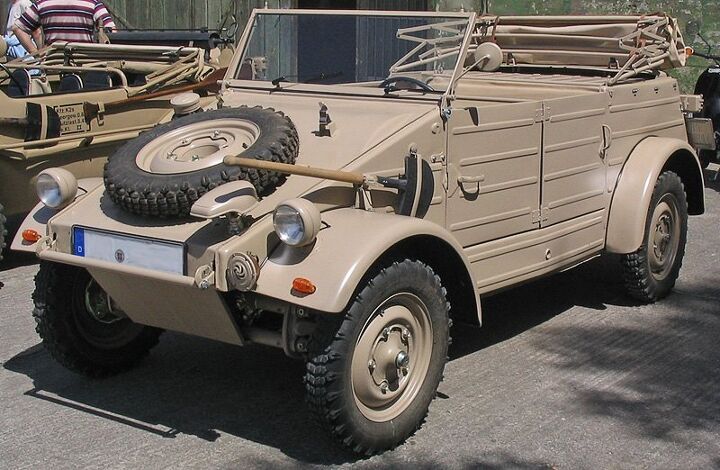VW Kbelwagen and Schwimmwagen: Germany's WW2 Jeeps

That Ferdinand Porsche’s Volkswagen Beetle would permute into a highly successful off road capable troop transport vehicle in a matter of one month was one of the more remarkable and successful adaptations in automotive history. And that the first mass-produced light amphibious vehicle was the second adaptation added to the growing reputation of the VW and the Porsches. In almost every way the opposite of the specifically-designed American military Jeep, the battle of the two has never quite ended, and their respective fans still argue as to which was the better vehicle. It’s a bit like comparing a tractor and a sports car: it depends on the job at hand.
While the KdF wagen (Volkswagen Beetle) was not designed specifically from the outset to have military application, it was clear to the military planners that it had the potential. Already in January 1938, prior to the completion of the VW factory, an order to develop a miltary version was given. The first version, the Type 62 (prototype above), cobbled up by Ferry Porsche in a month, was essentially a Type 1 (Beetle) with a primitive body and 19″ tires to give it added ground clearance. It was pressed into service for the 1939 Polish invasion, and although it acquitted itself well enough, certain shortcomings in that first outing needed to be addressed.
The Type 62 lacked gearing low enough to allow it to crawl along at 2.5 mph, the speed of walking troops. And sitting on the Type I chassis, its ground clearance and off road capability were modest. Ferry Porsche headed up a complete redesign, commonly know as the Type 82, but actually the Type 2 in VWs internal numbering system.
A sturdier platform frame, and the use of reduction gears on the ends of the rear axle shafts were the most significant and critical changes. The reduction gears not only brought the gearing down for the walking tempo, but was more favorable in war terrain overall. And they had the benefit of increasing ground clearance, along with corresponding change in the front suspension mounting location. And it received a more substantial body, which was built by Ambi-Budd, an American-owned company.
One of the Kübelwagen’s most remarkable features was its use of a limited slip differential, the first application ever outside of the legendary thirties Audi GP cars, for which purpose it was first invented. It was the key ingredient (along with the rear engine and light weight) that allowed the VW to be effective off-road without having four wheel drive. In fact, under certain situations, like crossing a trench on the diagonal, a four wheel drive vehicle like the Jeep could potentially get hung up if one wheel on each axle was briefly suspended in the air.
The Type 82 Kübelwagen was about as different from the Jeep as possible, and as alluded to at the top, they both had respective strengths and weaknesses. Clearly, the 985 cc 22.5 hp VW lacked the grunt power of the 60hp Jeep, which made it much more suitable for towing. But the Jeep rode on a precariously short and and narrow wheelbase, with a tall body sitting high above the frame and and running gear. The number of deaths from Jeep rollovers was insignificant in the big picture, but alarmingly high nevertheless. And the Jeep rode roughly, especially for anyone who had the misfortune to have to ride on the rear seat directly over the axle. And with a party of four aboard, the Jeep had no extra carrying space, unless in a trailer. The high metal doors and bodywork of the VW also provided a bit more protection from the elements and might even slow down a bullet. And there was room for luggage behind the back seat.
The VW was certainly the more comfortable of the two for its passengers, with its four bucket seats (that gave their name to the vehicle; a shortened version of Kübelsitzwagen) well within the axle lines. Its center of gravity was lower, and the long-stroke fully independent suspension gave a vastly superior ride and handling. The Jeep, whose origins reflected the deep mud conditions of the American Midwest, made a great tractor; the Kübelwagen, which was a product of more densely built up Europe, was a comfortable transport.
Even in the Sahara, Rommel’s troops were well served in their Type 82s equipped with 690×200 airplane tires. Air cooling had its obvious benefits wherever stray bullets fly. And the Kübelwagen’s flat smooth belly allowed it to slide over sand, snow or mud.
There are conflicting stories about what the Americans thought of the VW. According to wiki: “In November 1943, the U.S. military conducted a series of tests as well on several Type 82s they had captured in North Africa; they concluded that the vehicle was simpler, easier to manufacture and maintain, faster, and more comfortable for four passengers than the U.S. Jeeps. This statement is at odds with U.S. War Department Technical Manual TM-E 30-451, Handbook on German Military Forces, dated 15 March 1945. In this manual (p. 416), it states “The Volkswagen, the German equivalent of the U.S. “Jeep”, is inferior in every way except in the comfort of its seating accommodations.”
Not really surprising, given the nature of military politics; even the German High Command had conflicting opinions about the Type 82. They initially resisted the Kübelwagen until Hitler himself forced the issue.
As an interesting aside, captured Kübelwagen were put to use by the Americans, and resulted in the first comprehensive English-language Technical Manual for the operation and service of the Volkswagen in 1944. Regardless of what the US high command thought of the VW, plenty of GIs came home with positive memories or grudging respect, helping the Volkswagen became a popular import in the early fifties based on its rep for toughness.
The VW’s basic drive train configuration made it eminently suitable to convert to four wheel drive, by extending the output shaft through the front of the transmission through the central tunnel. The Porsches obviously saw it too, and developed it, and a limited number of Kübelwagen were built with it. But the extra expense and weight didn’t justify themselves with enough added capability to make it worthwhile. The lack of four wheel drive on the Kübelwagen was a pragmatic and conscious decision.
Ironically, it was a Beetle-bodied vehicle, the Type 87 Kommandeurwagen that was given four wheel drive, in order to assure that its high ranking officers could get through (or away) even in the most extreme conditions.
Although the Kübelwagen acquitted itself very well, there was a perceived need for a more extreme-conditions vehicle, combining four wheel drive and amphibious capability. The Type 166 Schwimmwagen was a superb accomplishment, making it the most numerous mass-produced amphibious car in history.
Porsche chief designer Erwin Komenda had to design a completely new structure, as early tests with converting a Kübelwagen showed its smooth underbody to be totally unsuitable to moving through water. So a shorter, more boat-like unitized structure was designed, and it used the four wheel drive system from the Type 87 Kommandeurwagen.
The propeller was ingenious, as it was simple was flipped down in water, which caused it to engage in an extension from the the VW engine out the rear. There was no reversing it, of course; that’s why paddles were standard equipment. Steering was via the front wheels. The Schwimmwagen was given a larger 1100cc engine with 25hp, which soon also became standard on the Kübelwagen too.
Watching a Schwimmwagen drive right into the Inn River and cross it as a very young child left a deep impression, reenacting something I’d only experienced in dreams. Now if VW had built a Flugwagen, my even more more common dream of cars taking to the air would have been realized too. Given the VW’s remarkable adaptability, it’s almost surprising they didn’t.

More by Paul Niedermeyer
Latest Car Reviews
Read moreLatest Product Reviews
Read moreRecent Comments
- Theflyersfan OK, I'm going to stretch the words "positive change" to the breaking point here, but there might be some positive change going on with the beaver grille here. This picture was at Car and Driver. You'll notice that the grille now dives into a larger lower air intake instead of really standing out in a sea of plastic. In darker colors like this blue, it somewhat conceals the absolute obscene amount of real estate this unneeded monstrosity of a failed styling attempt takes up. The Euro front plate might be hiding some sins as well. You be the judge.
- Theflyersfan I know given the body style they'll sell dozens, but for those of us who grew up wanting a nice Prelude Si with 4WS but our student budgets said no way, it'd be interesting to see if Honda can persuade GenX-ers to open their wallets for one. Civic Type-R powertrain in a coupe body style? Mild hybrid if they have to? The holy grail will still be if Honda gives the ultimate middle finger towards all things EV and hybrid, hides a few engineers in the basement away from spy cameras and leaks, comes up with a limited run of 9,000 rpm engines and gives us the last gasp of the S2000 once again. A send off to remind us of when once they screamed before everything sounds like a whirring appliance.
- Jeff Nice concept car. One can only dream.
- Funky D The problem is not exclusively the cost of the vehicle. The problem is that there are too few use cases for BEVs that couldn't be done by a plug-in hybrid, with the latter having the ability to do long-range trips without requiring lengthy recharging and being better able to function in really cold climates.In our particular case, a plug-in hybrid would run in all electric mode for the vast majority of the miles we would drive on a regular basis. It would also charge faster and the battery replacement should be less expensive than its BEV counterpart.So the answer for me is a polite, but firm NO.
- 3SpeedAutomatic 2012 Ford Escape V6 FWD at 147k miles:Just went thru a heavy maintenance cycle: full brake job with rotors and drums, replace top & bottom radiator hoses, radiator flush, transmission flush, replace valve cover gaskets (still leaks oil, but not as bad as before), & fan belt. Also, #4 fuel injector locked up. About $4.5k spread over 19 months. Sole means of transportation, so don't mind spending the money for reliability. Was going to replace prior to the above maintenance cycle, but COVID screwed up the market ( $4k markup over sticker including $400 for nitrogen in the tires), so bit the bullet. Now serious about replacing, but waiting for used and/or new car prices to fall a bit more. Have my eye on a particular SUV. Last I checked, had a $2.5k discount with great interest rate (better than my CU) for financing. Will keep on driving Escape as long as A/C works. 🚗🚗🚗












































Comments
Join the conversation
I seem to remember reading somewhere that , for trading purposes in the U.S. Army during WW2, a Kubelwagen was worth 2 Jeeps . Don't remember who was trading the Kubelwagens , the Germans or the U.S Army .
Anyone know whether the Kubelwagen was in general use in the German air force and the German navy in WWII?